
|

Detail of 'Remains of the Body'. Photograph by Rosamond
Purcell, © 2000.
Click
for a larger, full image.
|
|
Remains
of the Body
The Mutter Museum of
the College of Physicians in Philadelphia houses a large collection
of 18th- and 19th-century specimens and artifacts that artists and
photographers are sometimes invited to work with. This particular
skull is one of a collection of 139 skulls from central Europe that
were donated to the museum by the 19th-century anthropologist Joseph
Hyrtl.
Hyrtl believed that the
body developed according to the environment, but that the mind developed
according to "Divine Will." He collected skulls to study the ethnic
characteristics he believed could be deduced from them. Like the
carving on a gravestone, the side of each skull is inscribed with
biographical information‹sometimes as much as birth date, name,
nationality, religion, occupation, and cause of death. This skull
came from the catacombs of St. Steven, but that is all we know about
the person.
I placed the skull on
a chromolithograph showing the dissection of a woman to imply that
in the beginning is the end: an historical past is implicit in every
birth. Because I have also worked in the catacombs in Palermo, I
photographed this particular head as a tribute to the Capuchin monks
whose mission is to preserve the remains of the dead.

|

Detail of 'Trepanned Skulls'. Photograph by Rosamond Purcell,
© 2000.
Click
for a larger, full image.
|
|
Trepanned
Skulls
This photograph is a
composition of the plaster casts of skulls from Peru that are currently
held by the Mutter museum in Philadelphia. It shows the post-surgical
effects left by the instruments of trepanation.
Trepanning is a universal,
historical method for drilling into the skull. It was used, among
other things, to treat headaches that were thought to be caused
by pressure on the brain. As I wrote in my book, Special Cases,
"Unlike the anthropological practice of cutting into the skull after
death to determine the shape (of the brain), trepanning occurred
while the patient was alive and it left neat borings and cross-hatchings
in the skull."
Although not visible
here, the wound often healed, indicating that the practice of drilling
holes in the skull does not necessarily kill the owner. Trepanation
is still practiced today by a small group of devoted advocates who
believe that unhealthy mental pressures are alleviated by this practice.
|

